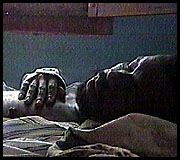
Ebola hemorrhagic fever (EHF), caused by Ebola Zaire, Ebola Sudan and Ebola
Cote d'Ivoire, "is often characterized by the sudden onset of fever, weakness,
muscle pain, headache and sore throat. This is followed by vomiting, diarrhoea,
rash, limited kidney and liver functions, and both internal and external
bleeding" (WHO Fact Sheet). Blood begins to
leak from every opening in the infected primate's body during the last stages
of Ebola hemorrhagic fever. Ebola Virus
Hemorrhagic Fever: General Information.
Researcher and Journalists' Descriptions of EHF
- Microbiologist David Simpson, Belfast's Queens University, Description of EHF Caused by EBO-CI:
"It's a fairly straightforward flu-like illness, which starts off with
severe headache and severe watery diarrhea. It's then followed by a rash,
a very, very sore throat--which feels like someone's rubbing a rope up
and down inside and that is then followed by severe bleeding which can
come from external orifices such as the nose, gums, the rectum and also
from the uterus. But there is also severe bleeding into the gastrointestinal
organs as well, with severe damage to the kidneys, liver and also the
spleen." From
an Outbreak interview.
- David L. Heymann, MD, Director of Emerging Viral and Bacterial Diseases,
Surveillance and Control, World Health Organization:
"The symptoms which occur in Ebola are very similar to those which occur
in may other diseases in tropical Africa. Fever, up to 40 degrees centigrade,
extreme fatigue, muscle and joint pain, headache, especially frontal headache,
hiccups (and hiccups in this case are a very bad sign.) They are associated
with a very severe prognosis probably because of irritation to the diaphragm,
ocular injection and in very light skinned persons a macular rash. After
the sixth day, on days seven and eight, there is actually a clinical improvement
in many cases and a decrease in fatigue and many persons feel extremely
well during this period. For many this is only the beginning of a cure
and as you know there is about a 30% survival rate in this disease. For
those unfortunate ones who don't survive on day nine onwards they begin
with hemorrhagic signs which you know well from having seen films from
the outbreak in Zaire. Bleeding from the orifices and eventually death.
So these are the signs and symptoms of Ebola which show that this disease
in its early phase is very difficult to distinguish from other diseases
in tropical Africa." From
his EIINet Seminar, 2 April 1996.
Signs and Symptoms of Ebola Hemorrhagic Fever:


